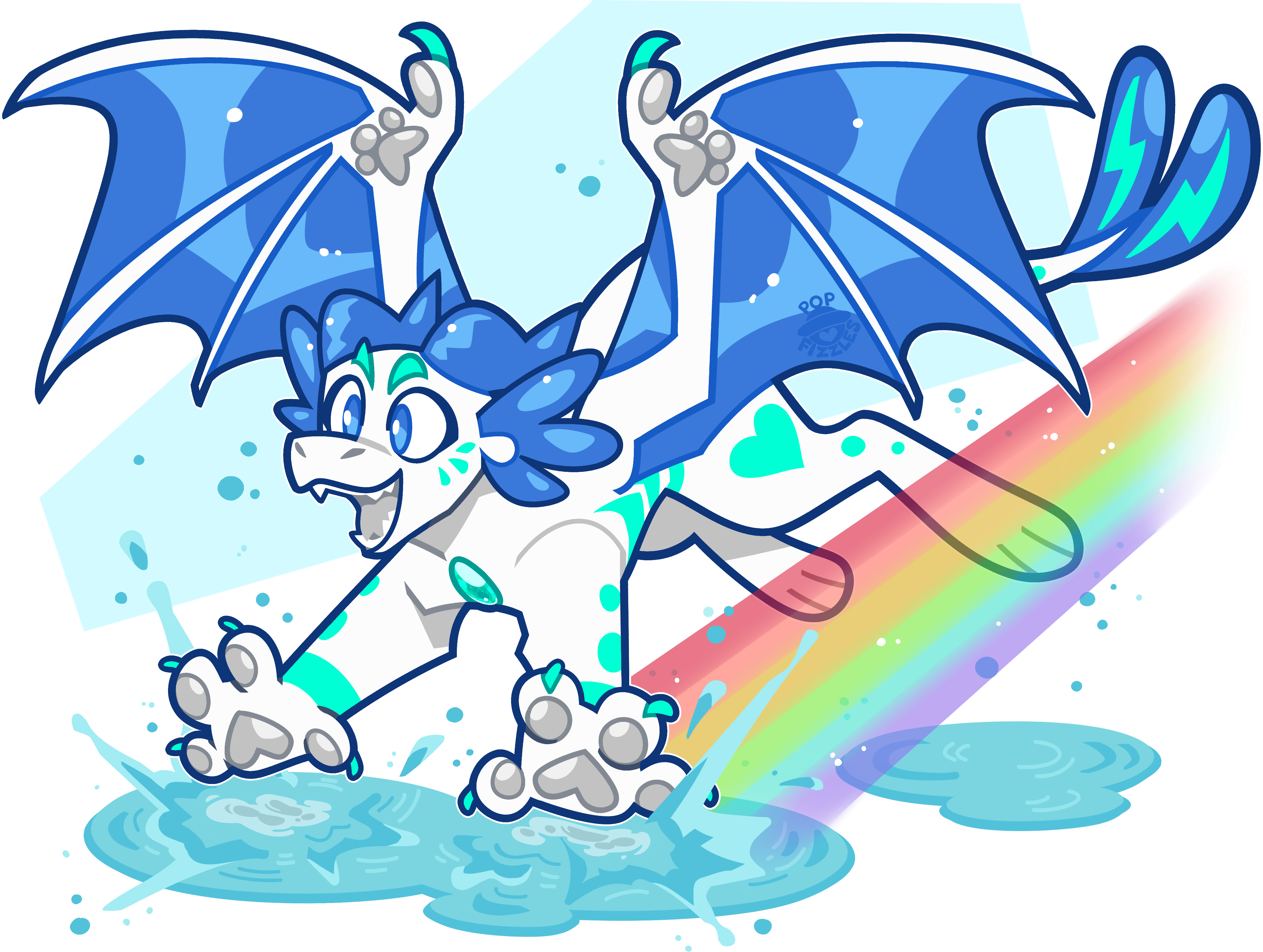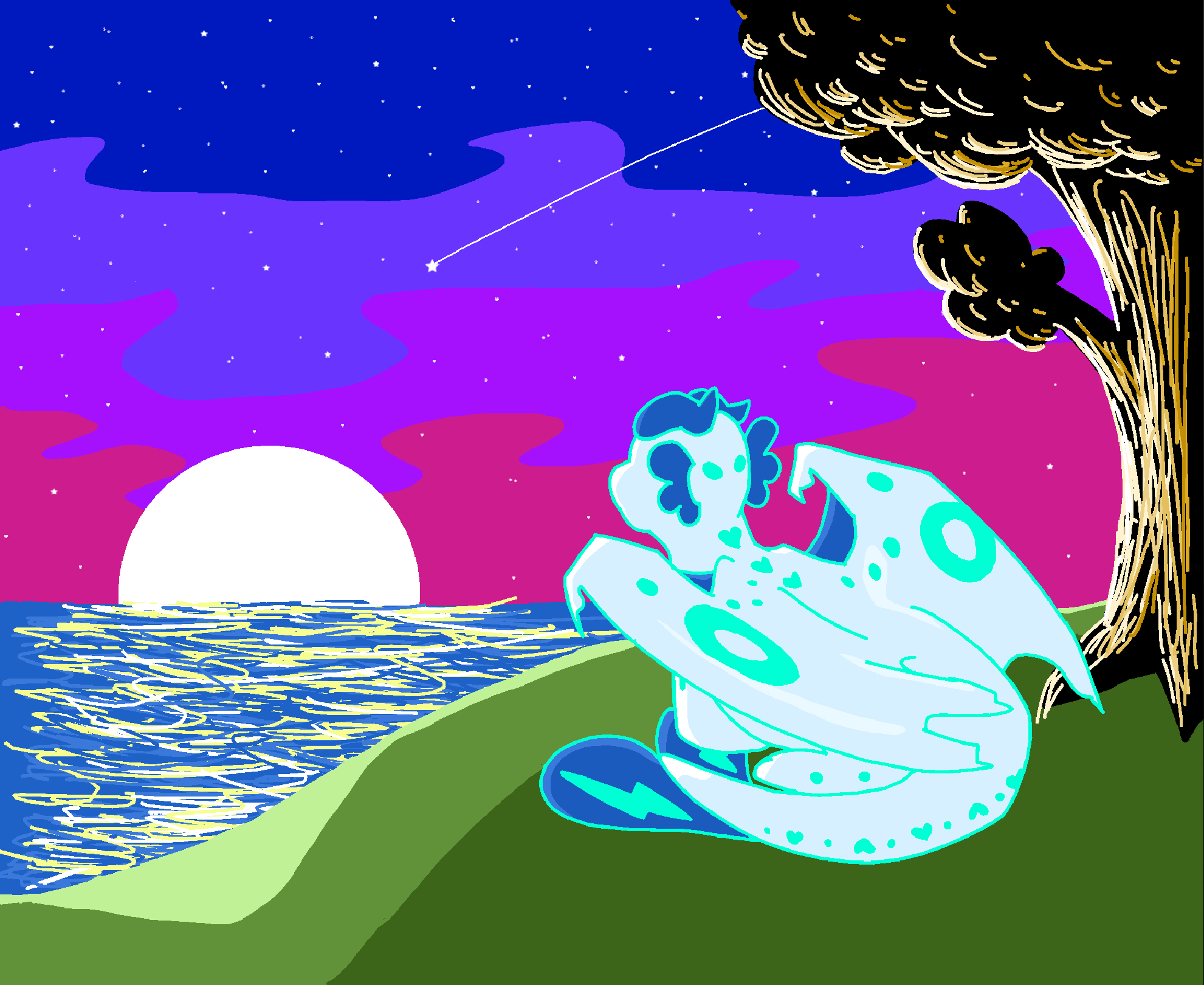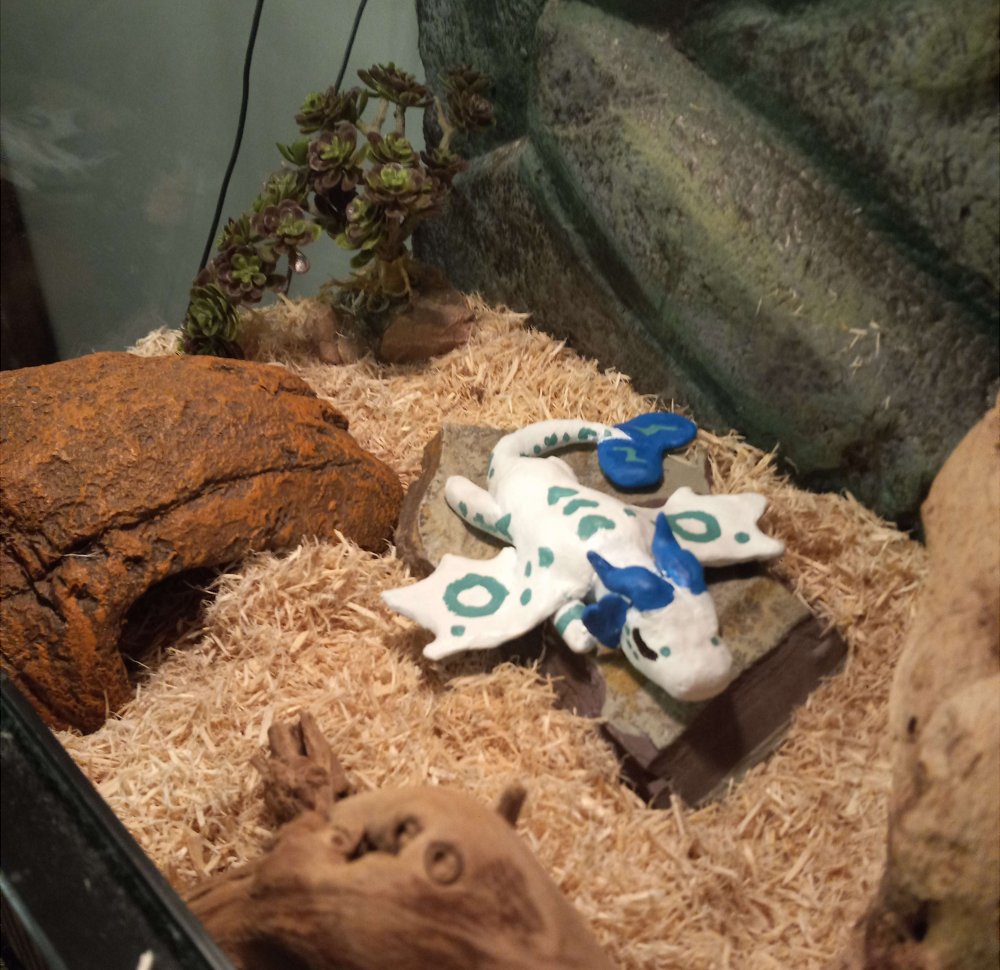Contents [hide]
The Standard Lunightian Reef Dragon (akesi telo kule) is an aquatic subspecies of the Lunightian Standard Dragon native to Blunder's Bay. Their markings are usually in a standard arrangement accross their face, wings, torso, limbs, and tail, with varying marking shapes between individuals.
Reef dragons are one of the only known species of dragons in which most individuals do not maintain Hoards aside from mages in need of greater magical benefits, or for those whose families place traditional importance upon them.
Reef dragons are also well known for being one of the smallest sentient species, standing at about 25 cm or ~10 inches tall on average when standing quadrupedally, with an average wingspan of 5.5 ft or about 1.6 m. However, past a certain age, they may grow exponentially and need to leave the Reef or even the Bay in its entirety to find a territory in the ocean. Other than this, it is not currently known how large or long-lived reef dragons can be, as interviewing those who have left the Reef is notoriously difficult and prone to issues on both sides.
Reef dragons are the only known species to eat the magically dense Coral that grows in Blunder's Bay, as its magic is too concentrated and potent for other species to eat safely in quantity without risking magical overload. However, reef dragons may also eat other types of seafood such as kelps and seaweed and most kinds of fish. These foods do not serve to satisy their high requirement for magical energy, but may fulfill other nutritional needs that coral cannot.
Reef dragons may have scales and bioluminescence of any hue and saturation, although primarily green or beige scales are both known to be exceptionally rare, and some superstitions say that encountering someone with these scale colors may bring good luck.
Some reef dragons have mentioned being able to communicate using their bioluminescence, although knowledge of how this communication functions exactly has not been revealed to the wider continent at this time, nor has a name for the language itself. Some believe that it is a hoax created and maintained by the species as a whole, due to the lack of concrete information about it.
As reef dragons are native to a magic-rich environment, they are one of the most magically powerful species known to Lunightia. Most reef dragons are capable of more powerful spells at a younger age than average, and this comes with the drawback of having a much lower tolerance for magical depletion, which is known to be much more deadly among reef dragons than other species if gone untreated.
| Standard Lunightian Reef Dragon | |
 |
|
| Image by @Popfizzles | |
| Scientific Classification | |
| Native Name | akesi telo kule |
| Literal Translation | Colorful Water Lizard |
| Magical Affinity | High |
| Ecological Role | Apex Predator |
| Colors | Any |
| Range | |
 |
|
| Native range in red | |
Description

Image by @Faithdragon36.
Abilities
Reef dragons naturally have bioluminescence that can be triggered at will. This can be in any color, but the most common ones are white or some shade of blue. This can be utilized for seeing in the dark, or, in rare cases, for stunning opponents in battle. Most reef dragons cannot light up their entire body without the use of magic, although there have been dragons who could do this historically. However, at present, it seems that the gene for this ability has been lost. Common locations for a reef dragon to be able to light up are the patterns on their face, torso, limbs, and tail, their gills, their irises, and the inside of their mouth or back of their throat. One case of a reef dragon who was able to use xyr paw pads for this ability has also been recorded, although no others are known to have the same mutation.
As mentioned above, reef dragons tend to be exceptionally powerful mages when they choose to study magic. Many historical mages known for their power were reef dragons. Reef dragons are more inclined towards water-based Affinities, but Affinities for air, darkness, and even colors are not uncommon among them. This is one of the reasons why the field of water magic is so well-studied compared to others such as time or conceptual magic.
Dragons may charge any item in their Hoard and drain this charge remotely at any time for a power boost, akin to a magical battery. This backup energy in addition to reef dragons' already boosted magical threshold skyrockets the spellcasting abilities of any mage who maintains a large hoard and keeps even a fraction of it Charged. Crystals are a common Hoard choice among mages given their ability to store raw magic in addition to every type of known refined magic, but more specialized mages will likely choose something better at holding a specific type of magical energy instead, such as a greenhouse of Charged plants, a collection of seashells, or a specific type of gemstone.
Characteristics
Reef dragons can have scales of any hue, brightness, and saturation, although brightly-colored scales falling somewhere on the rainbow are the most common, excepting green. The same can be said of their bioluminescence, although in that regard green is actually a rather common color and it is orange that is the rarest (However, unlike green scales, there are no popular supersitions about dragons with orange bioluminescence). Reef dragons may have eyes of any color, although many reef dragons' eyes look blue from certain angles. It is currently unknown why or how this occurs.
Reef dragons have one set of two symmetrical horns. These usually curve backwards and do not branch, split off, form loops, or twist. Horns that extend away from their heads more than ~4 inches (10 cm) are relatively uncommon, as are horns that curve forward instead of back. However, horns that stay close to their heads often grow to much greater lengths, although the growth patterns of these horns tend to be extremely curled or spiralled, which makes it seem that this increased growth actually being a property of these horn patterns rather than a trait of reef dragons as a species.
Reef dragons may possess external ears, but most do not. Instead, their head fins are highly adapted to serve the purpose of hearing underwater sounds and are also much more durable for underwater environments than external ears. These fins have a variety of shapes and are always the same color as their horns and wing and tail fin membranes. They are often colloquially referred to as "earfins" for their similar placement and function to ears in non-aquatic species.
Reef dragons' paws (sometimes called talons by other dragons, although reef dragons to not refer to their paws in this way) have webbing in between the digits, protractile claws, and standard reverse-heart paw pads. Many reef dragons have a marking on the backs of their front paws that they are capable of lighting up with their bioluminescence. They may have four or five fingers, depending on the dragon's genes. Some reef dragons have dewclaws, while others do not.
Reef dragons' tails tend to be between 1 to 1.5 times the length of their torso, lined with bioluminescent markings, and end with two symmetrical tail fins. These are used for steering while in flight or a strong underwater current. They may have a variety of shapes and are always the same color as their horns and wing and head fin membranes. The shape of a dragon's tail fins tend to match the shape of their head fins, but this is not always the case.
Reef dragons have two symmetrical non-feathered wings, one on each side of their body. These may be utilised for flight, swimming, combat, body language expression, or, in some rare cases, camoflauge. Their wings have exposed membranes on the ventral side and scales matching the rest of their body on the dorsal side, usually with bioluminescent patterns. The exposed wing membranes are the the same color as their horns and head/tail fins. Some dragons have a vestigial extra wing finger lacking flight membrane and/or paw pads on their wings, and some do not.
All reef dragons have gills which may be used to breathe underwater in addition to lungs that breathe air. Their gill slits may be located either on the sides of their torso, between the ribs, or the sides of their neck. Some individuals may have gill slits in both locations, but usually only one set is truly functional. Gills on the torso are almost always included in the at-will bioluminescent abilities of the dragon, while gills on the neck are very rarely included. Why this is is unknown, although it is theorized that the bioluminescent markings which occur on the torsos of those without torso gills and not on those with torso gills may have something to do with it.
Habitat

Image by @KittyAcelia.
This section will discuss the native habitat of reef dragons. Many reef dragons live outside of these locations, near or in any moderately-sized body of water on Lunightia, and many more live in the
Blunder's Bay
Main article: Blunder's Bay
Blunder's Bay is the largest single body of water in Lunightia. It is predominantly known for being a popular tourist attraction. However, it is also one of the two native habitats for reef dragons. More specifically, Blunder's Reef is where reef dragons hail from. It is the most diverse known aquatic ecosystem in Lunghtia, and contains over 100 different species of fish alone. Because of its relative proximity to Blunder and his extremely powerful ambient magic, the life of the reef has evolved to be extremely high in magic and resilient to overload.
Additionally, the Griffin Isles are suspended above the Bay, and often cast shadows across large areas of the water and beachfront. Some islands are stationary or have consistent movement patterns, while others are erratic or unpredictable, causing much of the Bay's native wildlife to be differently adapted depending on how frequently or infrequently their habitat is in shadow, and leading to a large degree of biodiversity, especially in the area's microscopic and stationary species.
Griffin Isles
Main article: Griffin Isles
Etiam sem sem, porta sit amet volutpat non, varius non nisi. Cras libero purus, auctor ac elit at, pellentesque condimentum lacus. Ut eu sapien in nunc tincidunt efficitur. Aenean luctus lorem libero, a ornare arcu viverra a. Morbi mollis nec tortor nec sodales. Vivamus mattis tellus in tortor efficitur, quis varius ipsum tristique. Aliquam eget purus nisi.
Outside Lunightia
Donec volutpat volutpat diam, at ullamcorper purus lobortis quis. Pellentesque odio lorem, condimentum eu pellentesque eu, varius nec lacus. Nunc turpis felis, bibendum vel magna eget, fermentum ultricies mauris. Etiam pretium diam vel erat suscipit, quis finibus lectus ullamcorper. Phasellus placerat dolor nibh, eu convallis ex pretium commodo. Duis vulputate odio eget dolor rhoncus, nec elementum nibh pretium. Ut hendrerit tortor purus, eget tincidunt massa iaculis id. Morbi eleifend erat vel metus luctus, eu pellentesque libero gravida.
Culture

Image by @Popfizzles.
This section will discuss the unique culture of Reef Dragons, both in the general sense as a species, and in terms of notable communities where possible. This section is always growing and improving, so it may be missing information, context, or details. Additionally, some information and communities have been requested to be excluded from public record. Please see the statement issued by the former Semi-Acquatic Species Cave Diving Association for more information.
Social Structure
Although similarly named, a babble of reef dragons and a brook of reef dragons are not the same thing. A bable of reef dragons is simply their plural noun, referring to any group of four or more reef dragons together. A brook of reef dragons is a group of relatives, family members, or close friends, including other species as honorary members in some circumstances. While the separation may be easy to dismiss as semantic, especially for species with analogous words such as pack and flock which cover both concepts, it is still an important distinction in reef dragons' culture, and should be noted as such.
Mauris vestibulum ut dolor luctus faucibus. Phasellus placerat ac nisl et viverra. Nunc euismod ligula porttitor mi hendrerit, faucibus congue nulla pulvinar. Aliquam maximus iaculis enim. Nunc tortor nisi, hendrerit sed iaculis sed, maximus sit amet odio. In semper dictum dignissim. Integer mauris lectus, ullamcorper ac auctor quis, interdum id est. Duis sit amet cursus lacus. Curabitur non facilisis justo, eu varius leo. Sed a justo orci. Etiam finibus maximus maximus.
Etiam sem sem, porta sit amet volutpat non, varius non nisi. Cras libero purus, auctor ac elit at, pellentesque condimentum lacus. Ut eu sapien in nunc tincidunt efficitur. Aenean luctus lorem libero, a ornare arcu viverra a. Morbi mollis nec tortor nec sodales. Vivamus mattis tellus in tortor efficitur, quis varius ipsum tristique. Aliquam eget purus nisi.
Subheader 6
Donec volutpat volutpat diam, at ullamcorper purus lobortis quis. Pellentesque odio lorem, condimentum eu pellentesque eu, varius nec lacus. Nunc turpis felis, bibendum vel magna eget, fermentum ultricies mauris. Etiam pretium diam vel erat suscipit, quis finibus lectus ullamcorper. Phasellus placerat dolor nibh, eu convallis ex pretium commodo. Duis vulputate odio eget dolor rhoncus, nec elementum nibh pretium. Ut hendrerit tortor purus, eget tincidunt massa iaculis id. Morbi eleifend erat vel metus luctus, eu pellentesque libero gravida.
Reference pages (to be removed upon completion): Maned Wolf, Grackle, Blue Whale, Faith Grayson.
Layout by @Splooto | Code by AviCode